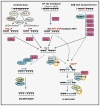Oxidized base damage and single-strand break repair in mammalian genomes: role of disordered regions and posttranslational modifications in early enzymes
- PMID: 22749145
- PMCID: PMC3531629
- DOI: 10.1016/B978-0-12-387665-2.00006-7
Oxidized base damage and single-strand break repair in mammalian genomes: role of disordered regions and posttranslational modifications in early enzymes
Abstract
Oxidative genome damage induced by reactive oxygen species includes oxidized bases, abasic (AP) sites, and single-strand breaks, all of which are repaired via the evolutionarily conserved base excision repair/single-strand break repair (BER/SSBR) pathway. BER/SSBR in mammalian cells is complex, with preferred and backup sub-pathways, and is linked to genome replication and transcription. The early BER/SSBR enzymes, namely, DNA glycosylases (DGs) and the end-processing proteins such as abasic endonuclease 1 (APE1), form complexes with downstream repair (and other noncanonical) proteins via pairwise interactions. Furthermore, a unique feature of mammalian early BER/SSBR enzymes is the presence of a disordered terminal extension that is absent in their Escherichia coli prototypes. These nonconserved segments usually contain organelle-targeting signals, common interaction interfaces, and sites of posttranslational modifications that may be involved in regulating their repair function including lesion scanning. Finally, the linkage of BER/SSBR deficiency to cancer, aging, and human neurodegenerative diseases, and therapeutic targeting of BER/SSBR are discussed.
Copyright © 2012 Elsevier Inc. All rights reserved.
Figures


Similar articles
-
Oxidative genome damage and its repair: implications in aging and neurodegenerative diseases.Mech Ageing Dev. 2012 Apr;133(4):157-68. doi: 10.1016/j.mad.2012.01.005. Epub 2012 Jan 31. Mech Ageing Dev. 2012. PMID: 22313689 Free PMC article. Review.
-
Early steps in the DNA base excision/single-strand interruption repair pathway in mammalian cells.Cell Res. 2008 Jan;18(1):27-47. doi: 10.1038/cr.2008.8. Cell Res. 2008. PMID: 18166975 Free PMC article. Review.
-
A short review on the implications of base excision repair pathway for neurons: relevance to neurodegenerative diseases.Mitochondrion. 2014 May;16:38-49. doi: 10.1016/j.mito.2013.10.007. Epub 2013 Nov 9. Mitochondrion. 2014. PMID: 24220222 Review.
-
Functions of disordered regions in mammalian early base excision repair proteins.Cell Mol Life Sci. 2010 Nov;67(21):3573-87. doi: 10.1007/s00018-010-0485-5. Epub 2010 Aug 17. Cell Mol Life Sci. 2010. PMID: 20714778 Free PMC article. Review.
-
Distinct spatiotemporal patterns and PARP dependence of XRCC1 recruitment to single-strand break and base excision repair.Nucleic Acids Res. 2013 Mar 1;41(5):3115-29. doi: 10.1093/nar/gkt025. Epub 2013 Jan 25. Nucleic Acids Res. 2013. PMID: 23355608 Free PMC article.
Cited by
-
DNA Repair and Ovarian Carcinogenesis: Impact on Risk, Prognosis and Therapy Outcome.Cancers (Basel). 2020 Jun 28;12(7):1713. doi: 10.3390/cancers12071713. Cancers (Basel). 2020. PMID: 32605254 Free PMC article. Review.
-
Analysis of Copy Number Variation of DNA Repair/Damage Response Genes in Tumor Tissues.Methods Mol Biol. 2023;2701:231-242. doi: 10.1007/978-1-0716-3373-1_15. Methods Mol Biol. 2023. PMID: 37574486
-
Reassessing the roles of oxidative DNA base lesion 8-oxoGua and repair enzyme OGG1 in tumorigenesis.J Biomed Sci. 2025 Jan 1;32(1):1. doi: 10.1186/s12929-024-01093-8. J Biomed Sci. 2025. PMID: 39741341 Free PMC article. Review.
-
Chronic oxidative damage together with genome repair deficiency in the neurons is a double whammy for neurodegeneration: Is damage response signaling a potential therapeutic target?Mech Ageing Dev. 2017 Jan;161(Pt A):163-176. doi: 10.1016/j.mad.2016.09.005. Epub 2016 Sep 20. Mech Ageing Dev. 2017. PMID: 27663141 Free PMC article. Review.
-
Human DNA Glycosylase NEIL1's Interactions with Downstream Repair Proteins Is Critical for Efficient Repair of Oxidized DNA Base Damage and Enhanced Cell Survival.Biomolecules. 2012 Nov 15;2(4):564-78. doi: 10.3390/biom2040564. Biomolecules. 2012. PMID: 23926464 Free PMC article.
References
-
- Dawson TL, Gores GJ, Nieminen AL, Herman B, Lemasters JJ. Mitochondria as a source of reactive oxygen species during reductive stress in rat hepatocytes. Am J Physiol. 1993;264:C961–7. - PubMed
-
- Griendling KK, Sorescu D, Ushio-Fukai M. NAD(P)H oxidase: role in cardiovascular biology and disease. Circ Res. 2000;86:494–501. - PubMed
-
- Lindahl T. Instability and decay of the primary structure of DNA. Nature. 1993;362:709–15. - PubMed
-
- Mitra S, Hegde ML, Theriot CA, Das A, Hegde PM, Hazra TK. Complexity in repair of oxidative genome damage and its regulation. Proceedings of princess Takamatsu symposium; Tokyo, Japan. 2009.
-
- Di Noia JM, Neuberger MS. Molecular mechanisms of antibody somatic hypermutation. Annu Rev Biochem. 2007;76:1–22. - PubMed
Publication types
MeSH terms
Substances
Grants and funding
LinkOut - more resources
Full Text Sources
Research Materials
Miscellaneous

